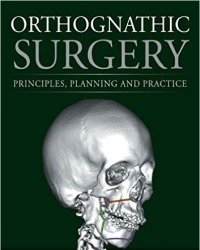F. Naini – Orthognathic Surgery (2017)
7.980 ₽
Автор: F. Naini
Название книги: Orthognathic Surgery
Формат: PDF
Жанр: Пластическая хирургия, Челюстно-лицевая хирургия, Ортогнатия
Страницы: 927
Качество: Изначально компьютерное, E-book
Orthognathic Surgery: Principles, Planning and Practice is a definitive clinical guide to orthognathic surgery, from initial diagnosis and treatment planning to surgical management and postoperative care.
Addresses the major craniofacial anomalies and complex conditions of the jaw and face that require surgery
Edited by two highly experienced specialists, with contributions from an international team of experts
Enhanced by case studies, note boxes and more than 2000 clinical photographs and illustrations
Serves as an essential reference for higher trainees and practicing clinicians in cranio-maxillofacial surgery, orthodontics, plastic and reconstructive surgery and allied specialties
Описание
‘Aesthetics and Function in Harmony’
Orthognathic surgery holds a unique position within
medicine and surgery. Firstly, it is a subspecialty of
two distinct surgical specialties: Oral and Maxillofacial
Surgery and Orthodontics. Secondly, orthognathic
surgical treatment, from the intricate details of diagnosis
and treatment planning through to the finesse
of surgical technique, requires the perfect blend of
art and science. Finally, unlike many other parts of
medicine and surgery, patients do not just ‘need’ such
treatment; they also ‘desire’ the treatment, and the
combined functional and aesthetic improvements may
be, quite literally, life-changing for the orthognathic
patient.
‘It is astonishing with how little reading a doctor can practice
medicine, but it is not astonishing how badly he may do it.’
Sir William Osler (1849–1919)
The fundamental purpose of this book is to provide
clinicians with comprehensive information regarding
diagnosis and treatment planning, and detailed, upto-
date, step-by-step descriptions of the specific operative
techniques in orthognathic surgery and relevant
procedures from allied specialties.
There is some ‘method’ in the arrangement of
the book. Considerable thought was given to the
order of the chapters, which have been grouped into
themed sections. This format should provide a logical
sequence to the reader. Attempts have been made
to reduce repetition, other than where a similar procedure
has been described with certain nuances of technique,
which readers may find useful. Any clinician
faced with a difficult situation will always benefit from
knowledge of several methods to deal with the problem
at hand.
The first chapter is a special introduction by Professor
Hugo Obwegeser, the leading pioneer of orthognathic
surgery. It is a pleasure to dedicate this textbook
to Professor Obwegeser. Countless patients owe
him the possibility to lead a normal life, and many surgeons
owe him success and satisfaction in their profession.
The photograph of Professor Obwegeser at
the beginning of the book was taken by Hengameh
Naini, in the Obwegesers’ garden in Schwerzenbach,
Switzerland. Professor Obwegeser asked if we didn’t
mind if he didn’t wear a suit and tie. He wanted to be
shown as himself, ‘not all dressed up.’ ‘I was raised
on a farm, and that is still where my heart lies.’ Professor
Obwegeser expressed his enthusiasm for this book,
and his desire ‘to hold the book in his hands.’ The editors
hope that he is pleased with the result.
The rest of the book is separated into two parts. A
house cannot be built on sand – a firm foundation
is required. Therefore the chapters in Part I (Principles
and Planning) cover the fundamental principles,
background considerations and essential information
that should be firmly grasped by the orthognathic
clinician. Part II (Clinical Practice and Techniques) is
separated into four sections. Section 1 covers Orthognathic
surgical planning and techniques; Section 2 covers
Adjunctive surgery; Section 3 covers Orthognathic
surgery in the cleft patient and orthognathic aspects
of craniofacial surgery; and finally Section 4 has two
chapters that will provide useful ‘food for thought’ for
the orthognathic clinician.
Many of the authors invited to contribute chapters
to this book are the internationally renowned leaders
in their field, and all have established reputations
in their respective sphere of interest. The list of contributing
authors reads like a veritable Who’s Who of
the masters of Orthognathic Surgery and allied specialties.
The contributing authors remit was to provide
chapters that were comprehensive and practical,
to analyse the scientific literature for their chosen
subjects, and, more importantly, to augment their
chapters with technical knowledge and wisdom gathered
from long-term clinical experience and careful
scrutiny of their techniques and clinical results, which
legitimately deserves to be considered as a vital part
of our ‘evidence base’. Referencing has been thorough,
but selective rather than exhaustive.
The most important part of learning orthognathic
surgery remains the apprenticeship – when
basic knowledge has been learned, and the higher
trainee spends time with an experienced surgeon and
orthodontist team. Observing an experienced clinical
team with a patient and their family on the clinic or
on the ward is invaluable, and teaching surgical technique
in the operating theatre is almost invariably a
one-to-one experience. To paraphrase a famous Oslerian
maxim: to study [orthognathic surgery] without books
it to sail an uncharted sea, while to study books without
patients is not to go to sea at all. To compile and write
a comprehensive book chapter on a specialist topic
must be a labour of love because the intellectual and emotional effort put into such an endeavour is incalculable.
The editors’ desire is that the chapters in this
book will be used by higher trainees to enhance higher
surgical training on diagnostic and treatment planning
clinics, on the ward and in the operating theatre.
Throughout the book there is an emphasis on
accurate diagnosis and logical treatment planning,
as well as the step-by-step description of technical
procedures, and the intricacies of surgical technique,
detailed in such a way that both the experienced clinician
and the higher surgical trainee may understand
the technical subtleties.
It may be reasoned that undertaking research educates
the researcher more thoroughly than anyone else;
by the same token, having had the opportunity to edit
manuscripts from the most accomplished individuals
in the field of orthognathic surgery, has been of enormous
value to us. We sincerely hope that our readers
derive as much pleasure and benefit from reading this
book as we have from compiling and editing it.





Отзывы
Отзывов пока нет.